Table of contents
Setting up
ROMs
This config depends on ROM files, which we can't distribute. Filenames and hashsums for the needed ROM files are provided here:
Boot floppy
You will need a boot floppy / startup disk for Windows 95 (Microsoft Windows 95 OSR2 - Boot Disk, such as a Dell OEM disc01.img boot floppy version). You cannot use FreeDOS. It may be possible to use appropriate floppy disks with a different hash given their creation method but it must be exactly the same versions of fdisk and format.
File: boot.img MD5: 8bdc30dcedbe6b16b6709c91a4af801b SHA-1: 6c1f2e365d2c0c7ce9499873ff47552eaeea4dd8
Windows 95 CD
You will need this specific CD for Windows 95b OSR 2 (release Windows 95B OSR 2.1 OEM final version 4.01.0971 B MS-DOS version 7.10 4.00.1111 built 06-25-97 + 09:07:10 build 4.01.0971).
File: windows95b.iso MD5: 5c3188e4685d19a98defc011395aaa6b SHA-1: c5684b0eb2428e033db8e6fe0d2075d0c4631fc9
Utilities CD
You will need to create a utilities / tools image using the tools below or you can download a premade image:
MD5: 9eac2f55a654566cbe792a8272141e66 SHA-1: edef1d34fb1b266fc4eac7f4003e5fbc06795eb3
Which contains:
Which was created using a bash script for making reproducible .ISO images.
Config
You can download and modify a premade windows95b.cfg file (change the paths to point to the correct files, with tools.iso replaced with the name of the Windows 95 utility disc .iso image you created or downloaded above).
You can optionally also make one yourself using the following specifications. If something is not specified, leave it at default. You may not get some of the options when you make a new config; if this happens, click "OK" to save it and then try editing it again.
- Machine: [Slot 1] Gigabyte GA-686BX
- CPU: Intel Pentium II/233
- Memory: 256 MB
- Synchronize time to host clock: Checked
- Device: 3DFX Voodoo 3 3000
- Click on the button with the tools and set Render threads to 1
- Speed: Fast VLB/PCI
- Voodoo Graphics: Unchecked
- Device: Sound Blaster AWE32
- Click the tools button and set OPL to NukedOPL
- All options unchecked
- LPT Device: None
- HDD: [IDE] Standard IDE
- FDD1: 3.5" 2.88M
- FDD2: 5.25" 1.2M
- CD Model: PCemCD
- CD Speed: 72x
- Drive 0 Primary Master (C:): Hard drive
- Make a new hard drive with Custom type: Sectors 63, Heads 16, Cylinders 8374 (will result in 4121 MB)
- Or grab it here and rename it to windows95b.img if you don't want to create it yourself
File: windowsxp.img MD5: 43AEBF8BE7803A539B236364E29E70AE SHA-1: A0BC9411BF4A3F623B4FCAF532AD12EA530E35A4
- Drive 1 Primary Slave (D:): CD-ROM
- Mouse: 2-button mouse (PS/2)
Once this is made, find the config that you just named in
~/.pcem/configs/ and open it in a text editor. Set disc_a = /full/path/to/boot.img, cdrom_drive = 200, and set cdrom_path = /path/to/windows95b.iso;/path/to/tools.iso, substituting in the proper paths for the boot floppy, and for Windows 95 and utilities CDs.
In
~/.pcem/pcem.cfg, set confirm_on_stop_emulation = 0.
NVR
This chipset does not pull the default NVR from a file - just make sure that in
~/.pcem/nvr/ there is no NVR named after your config file (e.g. if your config is named windows95b, delete any file called windows95b.ga686bx.nvr.)
If you've launched the machine before, you'll need to delete the
.nvr file as well as ~/.pcem/roms/ga686bx/flash.bin.
Windows 95 libTAS movie file
At this point, run the Windows 95 installation movie to get our exact hashes:
Installation
The following section outlines every step needed to recreate the outcome generated by the Windows 95 installation verification movie file if you need to perform the installation manually.
Setting up BIOS
On the bootup screen, press the
Delete key to go to the BIOS menu. Select BIOS Features Setup and press Enter then go down to Boot Sequence and use PageUp/PageDown to select A,CDROM,C:
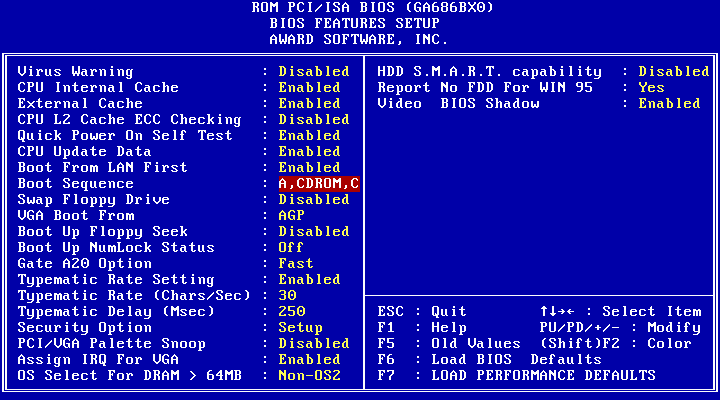
This will allow you to boot from the Windows 95 boot floppy at first because the hard drive is blank, and then when the hard drive becomes bootable and the floppy is ejected it will use that instead. Press
Escape and then select Save & Exit Setup on the main menu. Press Y and then Enter at the prompt.
Fdisk and format
When the PC reboots, optionally bypass loading drivers by pressing
F5 and wait to reach a DOS prompt. Type fdisk and hit Enter:

Press
Y and then Enter at the prompt to use FAT32 large disk support:

Press
1 and then Enter at the prompt to create a DOS partition:

Press
1 and then Enter at the prompt to create a Primary partition:
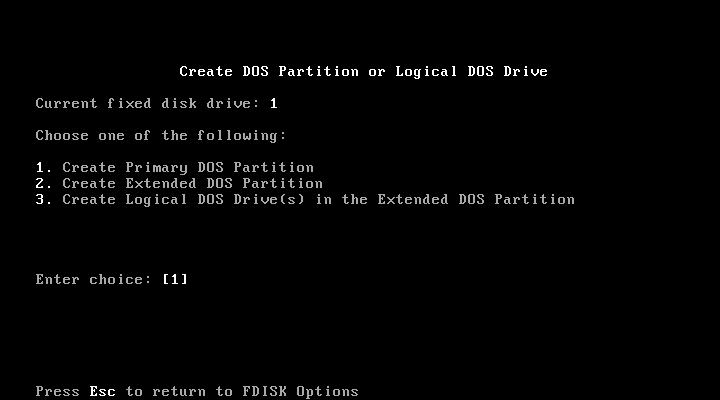
Press
Y and then Enter at the prompt to use the maximum size and mark the partition active:

Press
Escape at the prompt to exit fdisk:

Once fdisk has exited, reboot the PC. Press
1 and then Enter at the Windows 95 startup menu driver prompt to activate the "Load NEC IDE CDROM driver" option which will load the OAK Technology CD-ROM device driver with 1 drive present:

When the DOS prompt appears, type
format C: and hit Enter then press Y and then Enter at the confirmation prompt:

Once the full (not quick) format operation completes, press
Enter at the volume label prompt:

Copy and create Windows 95 setup files
Type
md c:\win95 and hit Enter to create the Windows 95 setup directory then type copy d:\win95 c:\win95 and hit Enter to copy the files:

Type the following commands, each followed by
Enter, to prepare installation files and launch Windows 95 setup in a manner that will reduce the number of dialog boxes during installation among other things, simplifying installation:
c:
cd win95
echo [setup]>msbatch.inf
echo ProductType=1>>msbatch.inf
setup msbatch.inf /is

Initial Windows 95 setup
Proceed through the Windows 95 setup screens, selecting the default installation directory of C:\WINDOWS when prompted, then click Next:

Keep the default Typical setup option, then click Next:

Put
. and . for Name and Company respectively, then click Next.

Select the Sound, MIDI, or Video Capture Card checkbox, then click Next:
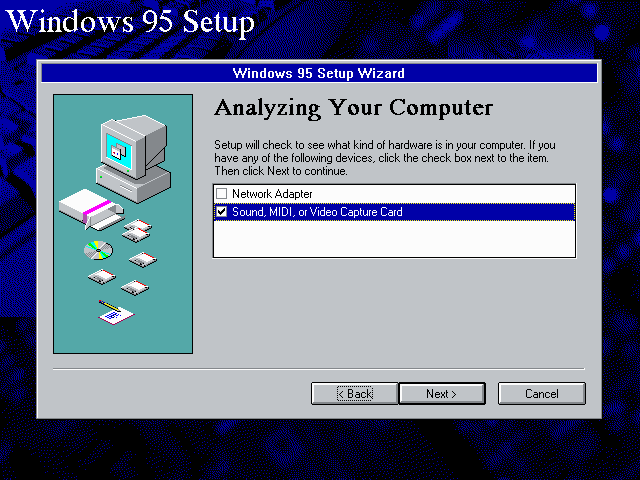
Select the Install the most common components radio box, then click Next:

Select the No, I do not want a startup disk radio box, then click Next:

Eject floppy and continue setup
Proceed through the copying files setup phase. When the system restarts, Eject the boot floppy by hitting
Ctrl + Period + Up Arrow to allow the system to boot from the C: hard drive. On the Date/Time Properties screen, press Down until the time zone is set to (GMT) Greenwich Mean Time: Dublin, Edinburgh, London, Lisbon, then click Close:
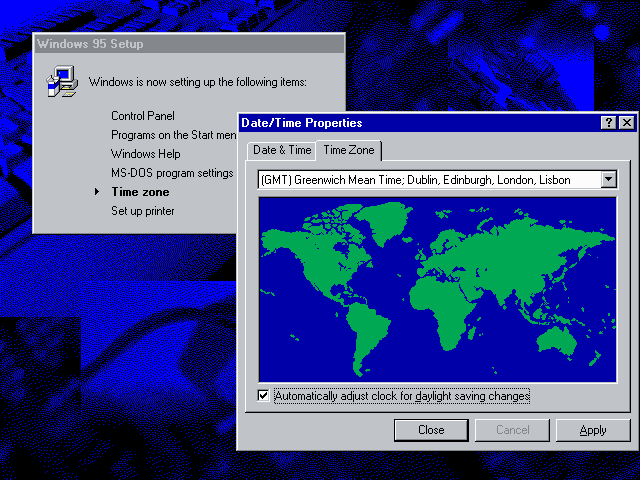
Press Cancel to decline adding a printer:

Initial settings and Voodoo driver install
Proceed when prompted. When the system restarts, Switch to the next CD in the list by hitting
Ctrl + Comma + Right Arrow and then Ctrl + Comma + Down Arrow.
Close the Welcome to Windows 95 dialog box for the first time then open My Computer on the Desktop. Select View, then Details to change the default view:
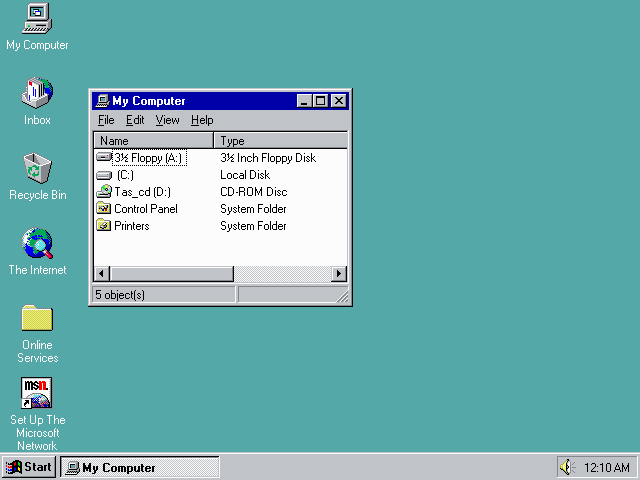
Select View, then Toolbar to display the tools information at the top:

Select View, then Options and select the radio box Browse folders by using a single window:

Switch to the View tab, then select the radio box Show all files and hit OK:
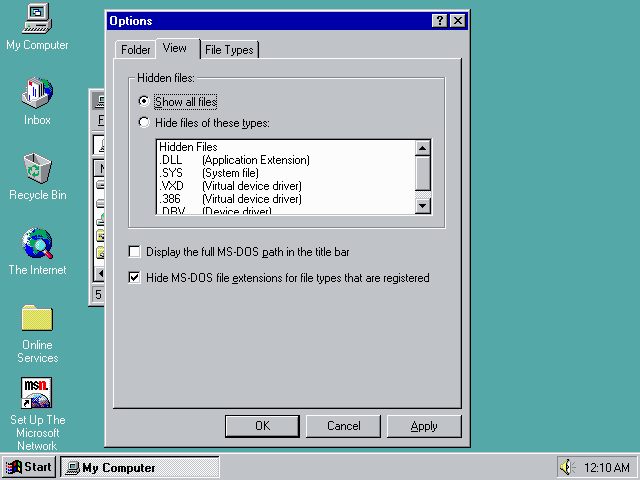
In My Computer, navigate to the D: drive and run the Voodoo installer:

In the Voodoo installer, uncheck 'When done unzipping run' and click Unzip:

When the installer finishes, close the Voodoo installation window, then open the control panel (Start menu -> Control Panel), open the Mouse settings, select the Motion tab, and reduce the pointer speed to Slow on the far left to disable pointer acceleration:

Close the control panel and run dcom95 to install the DCOM95 prerequisite:

When the DCOM95 installation completes, leave its restart prompt open and run C:\Windows\Temp\driver9x\setup from My Computer to install the Voodoo driver that was previously extracted:

When the driver installation completes, navigate to the Desktop view in My Computer, select Online Services, and press the
Delete key and select Yes to move the contents to the recycle bin:

Select Set Up The Microsoft Network and press the
Delete key and select Yes to move the contents to the recycle bin:
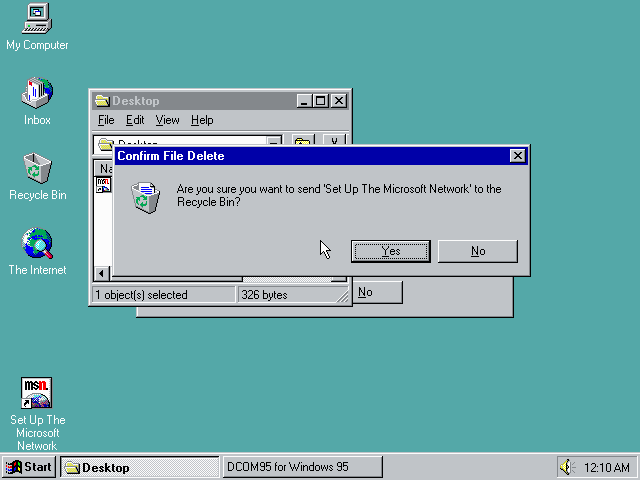
More settings and DirectX 8 install
Restart the computer (using the
Yes prompt in the DCOM95 installer). Windows will restart with a higher color depth and will again open the Welcome to Windows 95 window. Uncheck Show this welcome screen next time you start Windows and click Close:

On the desktop, select Inbox and press the
Delete key then select Yes to remove it:

On the desktop, select The Internet and press the
Delete key then select Yes to remove it:

Open Recycle Bin and select File -> Empty Recycle Bin and delete the contents:

In My Computer, navigate to the D: drive and run the DX80eng installer:
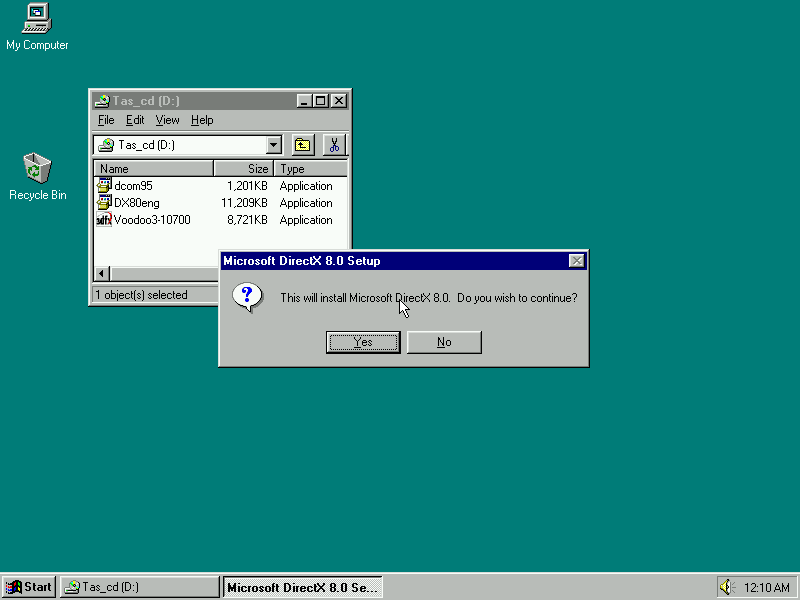
When the DirectX setup completes, close the My Computer window and press OK to restart the system:
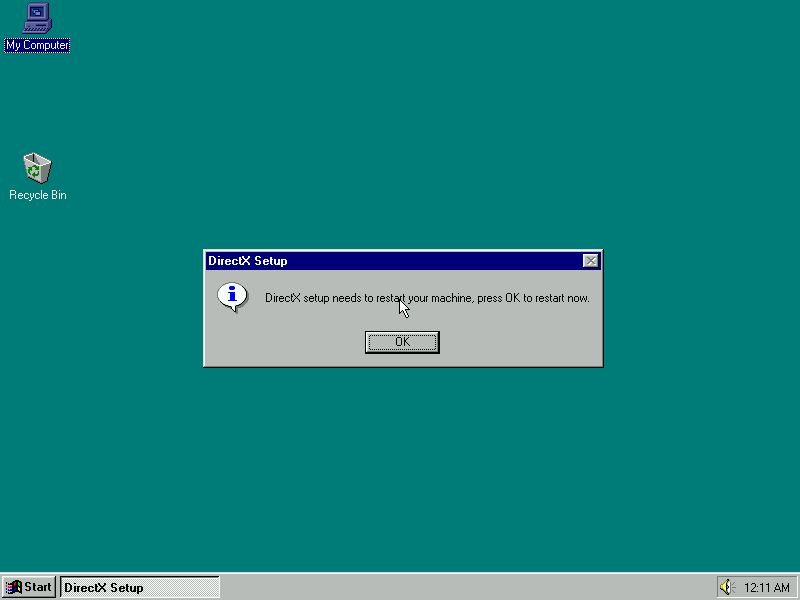
Display configuration and final settings
After restarting, open the Control Panel, open Display, click on the Settings tab, change the Color palette to True Color (32 bit) and the Desktop area to 1024 by 768 pixels, then click OK:
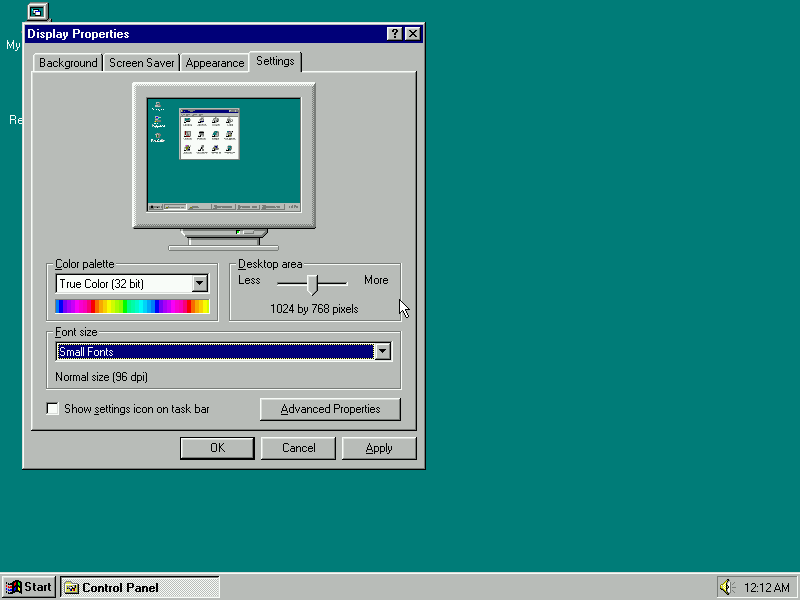
On the compatibility warning window, select OK to restart the computer with the new settings:
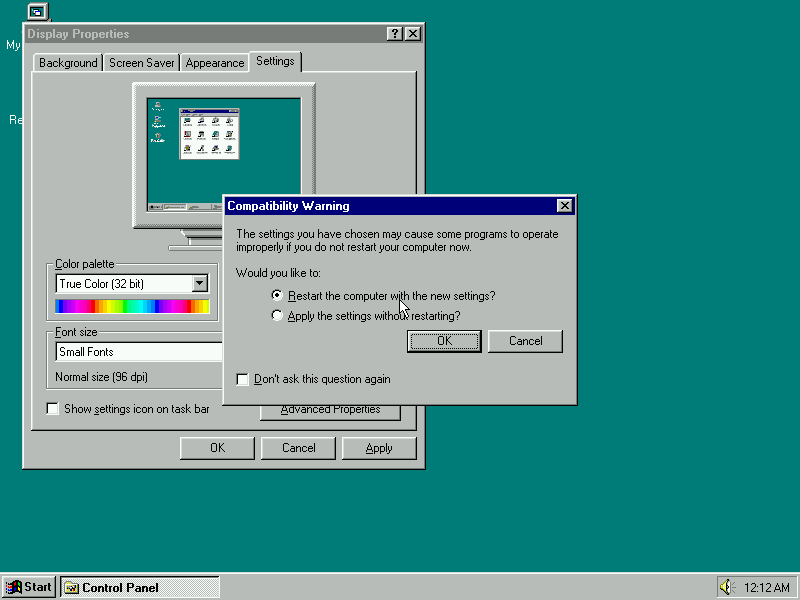
When Windows reboots to the larger desktop size and color depth, close the Control Panel, then shut down the computer:
